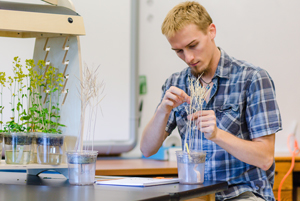Preservice teacher learners become effective teachers of science by developing strong content and content pedagogy knowledge that support all learners. In other words, the learning arc for preservice teacher learners is multilayered and jam-packed! So, it’s a tall order to hope that future teachers of science–elementary and secondary–are the solution to our national epidemic of plant blindness. “Plant blindness” may sound silly at first. However, the “inability to see or notice the plants in ones’s own environment,” aka “plant blindness” was first described in research published in 1999 (Wandersee & Schussler, 1999) and its widespread ramifications are affecting national and international policies. We believe preservice teachers can be pivotal for spreading the “plant vision” that is badly needed to support solutions for global conservation solutions.
Why is it important to overcome plant blindness?
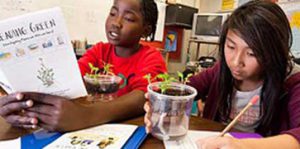
Global food security and critical threats to biodiversity are just two examples of grand challenges we’re facing with solutions that hinge–at a minimum–on appreciation for the importance of plants to our own survival. However, widespread plant blindness affects critical priorities and policies. For example, in 2011 plants made up 57% of the federal endangered species list in the US. But they received less than 4% of federal endangered species funding (Ro, 2019). To tackle these challenges and more, we need citizens who support prioritizing and funding for plant science research. In addition, we need teachers who give students learning opportunities with plants that promote plant science interest and careers.
Evidence supports the idea that early hands-on experiences growing plants have direct impact on curbing plant blindness (Wandersee & Schussler, 2001; Krosnick, Baker, & Moore, 2018; Jose, Wu, & Kamoun, 2019). Unfortunately, contemporary mainstream humans are now–more than ever–removed from direct contact with the natural world–and plants, in particular. So, it’s no surprise that both teachers and learners in typical urban classrooms likely have never grown a plant. Thus, any plan to eradicate plant blindness via science classrooms relies heavily on strengthening teachers’ confidence for working with plants and their commitment to fostering “plant vision.” And that is why preservice teachers could be key.
Preservice teachers come to know plants by growing plants
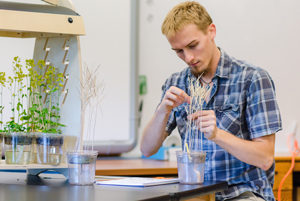
Daunting as coursework and practicum experiences may be, we need to give preservice teachers opportunities to grow plant knowledge and confidence. If we want preservice teachers to address their own plant blindness, where better than with mentors and colleagues in methods courses? Within the safety net of a practicum coursework, preservice teachers can grapple with “I have a brown thumb!” misconceptions, while learning firsthand about using plants as a living example, or model organism, for teaching science concepts.
Alternatively, if preservice teachers don’t get a chance to grow and practice teaching with plants, we can expect their students won’t likely learn with plants, either. Given we know how widespread plant blindness is in the US, it’s highly unlikely that preservice teachers will bring to their practices strong plant science knowledge or plant-growing confidence. And once these novice science teachers are hired into classrooms, only a small percent will make time–or even know to make time–to address their own and students’ plant blindness.
Moving beyond plant blindness with Fast Plants
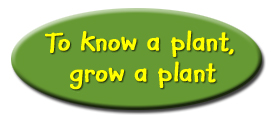
Wisconsin Fast Plants are an effective introduction to growing and noticing plants. Case studies and published research are evidence that Fast Plants serve as a model organism in preservice courses in a variety universities and colleges internationally–both in methods courses and course-based research experiences. Moreover, we know that students given the opportunity to grow fast plants become attached to their Fast Plants. As a result of their curiosity and anticipation for how their Fast Plants will grow and develop, learners of all ages can develop much greater awareness of and appreciation for plants (Frisch, Unwin, & Saunders, 2010). Therefore, we aim through the Fast Plants Program to strengthen our support for those who teach teachers by building and sharing open source resources that are explicitly designed for use with preservice teachers.
Fast Plants Program supports teachers of teachers to fight plant blindness
Working with a small group of educators who work preparing preservice teachers, the Fast Plants Program developed in 2019 a set of entry level lessons that model how pedagogical content learning goals can be wrapped around a model lesson, using plants. In these lessons, Ambitious Science Teaching practices for facilitating productive discourse are the pedagogical focus. In addition, the model lesson included is ready for classroom use (ideal for novice-teacher implementation) and is underpinned by NGSS standards-aligned lessons for teaching matter and energy concepts in the context of plants.
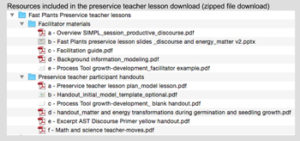
We invite you to download and try this complete set of lesson resources, including facilitation guides, PowerPoint facilitation slides, handouts, and background information. And because we want widespread introduction of plants into preservice experiences, we’ve designed the entire lesson for use without any need for grow lights or other specialized equipment. All you need are Fast Plants seeds, recycled deli-containers or Petri dishes, and a shared commitment to combat plant blindness!
Complete the form below to download the complete set of resources shown in the screenshot for teaching pre-service teachers a lesson they can practice with their students.
Then, please join our collaboration to design preservice learning experiences with Fast Plants to introduce plants as powerful model organisms early in teachers’ careers; we’d love to hear from you about how you’re working to promote plant vision!
To access these lesson materials through our Open Education Resource shared Google Drive, please complete the following:
We’d love to hear about how you foster appreciation for plants and stronger plant awareness in the comments.
Author: Hedi Baxter Lauffer directs Teaching and Learning for the Wisconsin Fast Plants Program in the Department of Plant Pathology at the University of Wisconsin–Madison. Her research and work with teacher professional development is closely tied to the SIMPL model.
References
Frisch, J. K., Unwin, M. M., & Saunders, G. W. (2010). Name that plant! Overcoming plant blindness and developing a sense of place using science and environmental education. In The inclusion of environmental education in science teacher education (pp. 143-157). Springer, Dordrecht.
, , . (2019) Overcoming plant blindness in science, education, and society. Plants, People, Planet, 2019; 1: 169– 172. https://doi.org/10.1002/ppp3.51
Krosnick, Shawn & Ramey, Kelly & Baker, Julie. (2018). The Pet Plant Project: Treating Plant Blindness by Making Plants Personal. The American Biology Teacher. 80. 10.1525/abt.2018.80.5.339.
(2019). Why ‘plant blindness’ matters – and what you can do about it, BBC. Retrieved June 7, 2019, from http://www.bbc.com/future/story/20190425-plant-blindness-what-we-lose-with-nature-deficit-disorder
, & (1999). Preventing plant blindness. The American Biology Teacher, 61( 2), 84– 86. https://doi.org/10.2307/4450624
, & (2001a). Toward a theory of plant blindness. Plant Science Bulletin, 47( 1), 2– 9.

